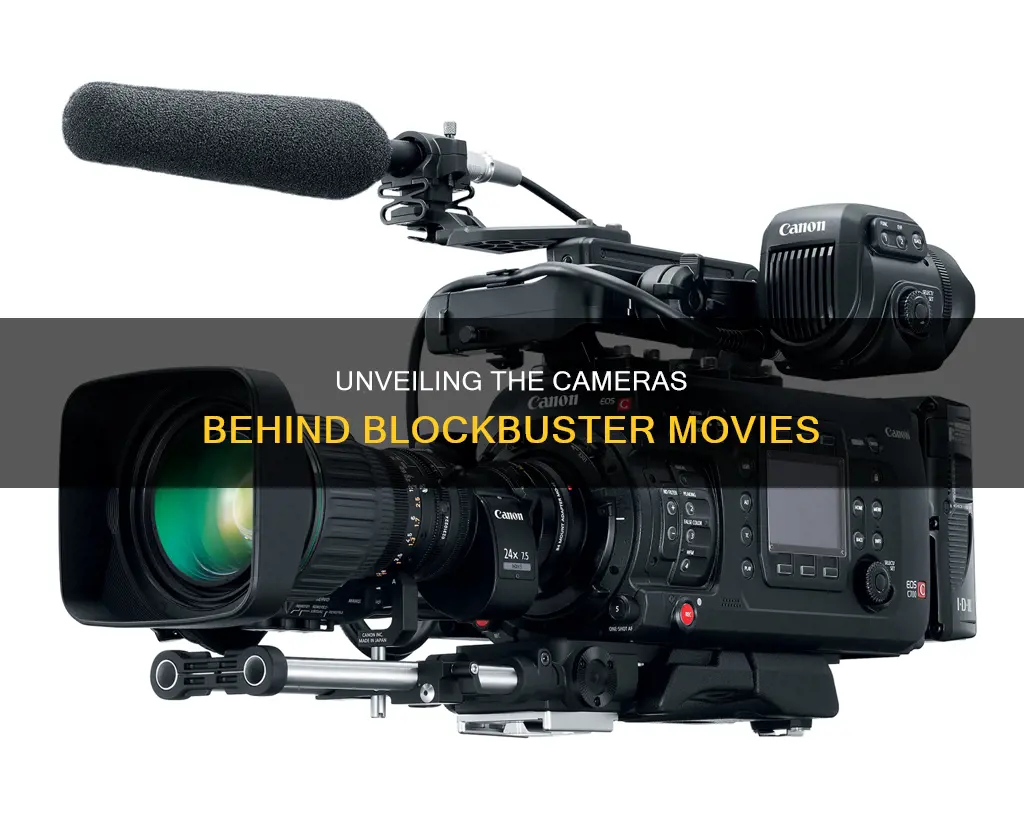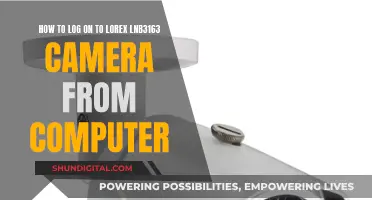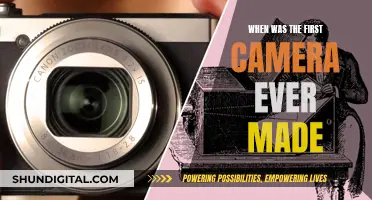
The camera used to shoot a movie can have a huge impact on the final product. Cinematographers and directors have to consider a range of factors when choosing a camera, from the desired aesthetic to the film's budget. While digital cameras have become the dominant type of camera in the motion picture industry, some directors, like Todd Phillips, are devoted to shooting on celluloid. Large-format cameras, such as the Alexa 65, are also changing the film language, offering immersive qualities that enhance both big-budget and smaller films.
| Characteristics | Values |
|---|---|
| Digital movie camera | ARRI Alexa, ARRI Alexa Mini, ARRI Alexa 65, Canon XL-1s MiniDV, Sony VX-1000, Panasonic AG-DVX100, Canon EOS 5D Mark II, Canon EOS 7D, ARRI Alexa XT, ARRI Alexa XT Plus |
| Film camera | ARRIFLEX 35, ARRIFLEX 35 BL, ARRIFLEX 435, ARRIFLEX 535, ARRICAM, Panavision Panaflex 35mm, Panaflex Millennium, Panaflex System 65 Studio, IMAX MKIV, IMAX MSM 9802, Millennium DXL, Millennium DXL2 8K |
What You'll Learn

ARRI cameras and films
ARRI cameras are a popular choice for filmmakers and have been used in the production of numerous notable films. ARRI, short for Arnold & Richter Cine Technik, is a German company that has been manufacturing motion picture film equipment since 1917. The company's first film camera, the Kinarri 35, was developed in 1924, and they have since introduced numerous innovations to the film industry.
One of the most well-known ARRI cameras is the Arriflex 35, which was the first camera to feature a reflex mirror shutter. This technology, invented by Erich Kästner, allows the camera to be operated continuously while providing a parallax-free viewfinder experience. The Arriflex series has seen many iterations over the years, including the Arriflex 16ST, the first professional 16mm camera with a reflex viewing system, and the Arriflex 16BL, a quiet and lightweight alternative to bulkier cameras.
In recent years, ARRI has continued to innovate with digital cinema cameras, particularly with the ARRI Alexa system. The Alexa was designed to be compatible with film equipment and offers a range of formats, including the LF series and the Mini LF, which was used to film "Dune." The Alexa's sensor has a high dynamic range and produces images with a unique, film-like texture. The camera is also known for its durability and reliability, making it a popular choice for major motion pictures.
ARRI cameras have been used in the filming of numerous award-winning films, including "Hugo" (2011), "Life of Pi" (2012), "Gravity" (2013), "Birdman" (2014), and "The Revenant" (2015). The Alexa 65, released in 2014, was used in the filming of "The Revenant", "Mission: Impossible – Rogue Nation", and "Star Wars: Rogue One." In addition to cameras, ARRI also offers a range of lenses, lighting, and post-production equipment, solidifying its place as a leader in the film industry.
The company's equipment is not limited to the film industry, however. ARRI's live entertainment technology has been utilised in sports broadcasting, concerts, and fashion shows, providing cinematic images and easy integration with third-party technology. Furthermore, ARRI Medical is a business unit that applies ARRI's camera technology to medical imaging and documentation, including the development of a fully digital 3D surgical microscope called the Arriscope.
Unlocking Manual Mode: How to Identify Camera Settings
You may want to see also

RED cameras and films
RED cameras have been used in the filming of several notable movies and television series. The camera was introduced in 2007 and immediately attracted the attention of filmmakers like Peter Jackson and Steven Soderbergh. Since then, directors have used RED cameras to shoot some of Hollywood's biggest movies.
Some of the films shot using RED cameras include:
- The Social Network
- The Girl with the Dragon Tattoo
- The Lord of the Rings
- Pirates of the Caribbean
- Spiderman
- The Secret In Their Eyes
- In A Better World
- Che
- The Informant
- The Amazing Spider-Man
- The Hobbit
- Prometheus
- Pirates of the Caribbean: On Stranger Tides
- The Great Gatsby
- The Lincoln Lawyer
- Gone Girl
- Guardians of the Galaxy Vol. 2
- Victoria & Abdul
- Swiss Army Man
- Super Dark Times
- Hold the Dark
- The Hitman’s Bodyguard
- Hacksaw Ridge
- Stranger Things
- Cooper’s Treasure
- Spooky Squad: Bigfoot’s Big Feat
- Jiro Dreams of Sushi
- The Girlfriend Experience
- My Bloody Valentine
RED cameras have also been used in television series such as Stranger Things and Cooper's Treasure.
RED Digital Cinema Camera Company, located in California, was founded in 1999 by Jim Jannard, who had no prior experience in the movie business. Jannard was an entrepreneur who had made a fortune with his line of Oakley sunglasses. Jannard's interest in cameras stemmed from his obsession with how the world sees things, according to Ted Schilowitz, RED's first employee and spokesman.
RED cameras offered several advantages over traditional film cameras, including being smaller, lighter, and cheaper while offering comparable image quality. The first RED model, introduced in 2007, was the Red One, which was Hollywood's first 4K digital cinema camera. The company has since released several new camera models, including the Epic-X, Scarlet, and more recently, the V-Raptor and Komodo lines.
Selfie Mode: When the Camera Captures Your Unaware Moments
You may want to see also

Panavision cameras and films
Panavision is an American motion picture equipment company founded in 1954. It specializes in cameras and lenses and is based in Woodland Hills, California. The company was formed by Robert Gottschalk to create anamorphic projection lenses during the widescreen boom in the 1950s. Panavision's first product was the Super Panatar projection lens, which was introduced in March 1954.
Over the years, Panavision has introduced several innovative cameras to the market, including the Panaflex 35 mm movie camera in 1972, which revolutionized filmmaking due to its lightweight design. They have also introduced other cameras such as the Millennium XL in 1999 and the digital video Genesis in 2004. The Millennium XL2, released in 2004, was the first Panavision camera to win both an Academy Award and a Primetime Emmy Award within a year of its release.
In addition to cameras, Panavision offers a range of advanced lenses, including the Ultra Panatar II, which maximizes lens adaptability for different aspect ratios, and the Panaspeed Spherical Lenses, which offer a blend of aberration correction and artistic nuances. The company also provides lighting equipment, such as the Panalux Allegra LED fixture range, delivering industry-leading color and white-light accuracy.
Panavision operates as a rental facility, owning its entire inventory, and has facilities in over a dozen countries, including the United States, the United Kingdom, Australia, Canada, France, and South Africa. The company supports filmmakers working on movies, television series, commercials, and beyond, providing equipment rentals, stage facilities, and post-production services.
Some notable films that have utilized Panavision equipment include "The Hateful Eight" (2015), "Star Wars: Episode II – Attack of the Clones" (2002), "Superman Returns" (2006), and "Mudbound".
Cellular Trail Cameras: How Long Do Batteries Really Last?
You may want to see also

Digital vs film cameras
The choice between digital and film cameras depends on the photographer's needs, preferences, and resources. Here is a detailed comparison of the two formats:
Digital Cameras
Digital cameras have become the dominant type in the motion picture industry since the 2000s. They offer several advantages over film cameras:
- Instant Feedback: Photographers can view their shots immediately after capture, making it easier to adjust and ensure they get the desired results.
- Adaptability: Digital cameras offer features like high ISO performance, long exposure capabilities, and rapid-fire shooting modes, allowing for experimentation in various lighting conditions.
- Lightweight: Digital cameras are generally lighter in weight compared to film cameras, making them more portable and easier to handle.
- Memory Cards: Digital cameras use memory cards that can store numerous images, eliminating the need for frequent film changes.
- Post-processing: Digital images can be easily edited and manipulated using software, giving photographers greater control over the final image.
- Cost-effective: Digital cameras have become more affordable, and with reusable memory cards, photographers can take thousands of pictures without incurring high costs.
- Special Features: Digital cameras often have built-in software that enhances images and settings that assist with focus, motion capture, and switching between colour and black-and-white.
Film Cameras
Film cameras, also known as analogue cameras, have their own set of advantages:
- Image Quality: Film is known for capturing images with rich, vibrant colours and fine grain. It has a higher dynamic range, capturing more detail in highlights and shadows.
- Resolution: Film can capture photos at a higher resolution than most digital cameras, resulting in sharper and more detailed images.
- Forgiving: Film is more forgiving of minor focusing issues and exposure problems, making it more flexible in challenging lighting conditions.
- Creative Control: Film photography offers a more creative and tactile experience, allowing photographers to experiment with different types of film and development processes.
- Longevity: Film cameras are future-proof and do not become obsolete. Film negatives can be archived and reproduced long into the future, whereas digital data storage has longevity concerns.
- No Power Required: Film cameras do not require power or batteries, making them ideal for long trips and cold conditions where power sources may be limited.
- Intentionality: Film photographers tend to be more deliberate with their shots due to the limited number of exposures, resulting in a more thoughtful approach to photography.
While digital cameras offer convenience and versatility, film cameras provide a classic, timeless aesthetic and a unique tactile experience. Ultimately, the choice between the two depends on the specific needs and creative vision of the photographer or filmmaker.
Latest Adobe Camera Raw: Unlocking Raw Power
You may want to see also

Prosumer and consumer cameras
When it comes to cameras, there are three main types: consumer, prosumer, and professional. Each type has distinct features and is suited to different levels of expertise.
Consumer Cameras
Consumer cameras are designed with basic functionality, where almost all functions are automatic, with very few features that can be manually set. The user is typically presented with a selection of modes such as "Sunset", "Sport", "Landscape", and "Auto" for all-environment shooting. On these cameras, the only functions that can be manually adjusted are the flash settings and the "close" focus setting. It is rare for consumer cameras to have manual focus ability, as this would be considered "difficult" by manufacturers. These cameras usually have a single built-in lens and cannot accommodate interchangeable lenses. Consumer cameras are ideal for those who want to capture memories without any technical know-how. They are uncomplicated, easy to use, and typically equipped with autofocus, auto gain control, and white balance.
Prosumer Cameras
Prosumer cameras, a combination of the words "professional" and "consumer", are the next level up from consumer cameras. They offer more advanced functionality and expose more features to the control of the user, who is assumed to have a greater understanding of photography and camera hardware. While prosumer cameras are still fairly basic, they provide some manual focus ability, albeit limited due to the integrated camera lens, which cannot be swapped out in most models. The manual focus is usually adjusted through a built-in menu rather than by physically turning the lens. Prosumer cameras are often compact, lightweight, and equipped with a wide-angle lens, making them excellent for capturing landscapes and architecture. They fill the niche between basic compact cameras and more advanced SLR (single-lens reflex) cameras.
Professional Cameras
Professional cameras are designed for photographers who desire absolute control over every aspect of their photos. They feature a full body with a removable lens, fully adjustable optical manual focus, and the ability to set all features to manual or automatic. The components of a professional camera are separated to allow the photographer more options. The body contains the inner workings and electronic mechanisms, while the lens, flash, and other items are separate. Professional cameras are not typically user-friendly and are not meant to be "point and shoot" like consumer or prosumer cameras. They are engineered to meet rigorous demands, offering superior image and sound quality, durability, and advanced customisation options.
Charging Camera Batteries: Alone Contestants' Strategies
You may want to see also
Frequently asked questions
ARRI's ALEXA line of cameras was used to shoot most of the films in the Marvel Cinematic Universe.
The film "The Catcher Was a Spy" was shot using an ARRI Alexa camera with Leitz lenses of various focal lengths.
"Colette" was shot using an ARRI Alexa camera with anamorphic primes lenses.







